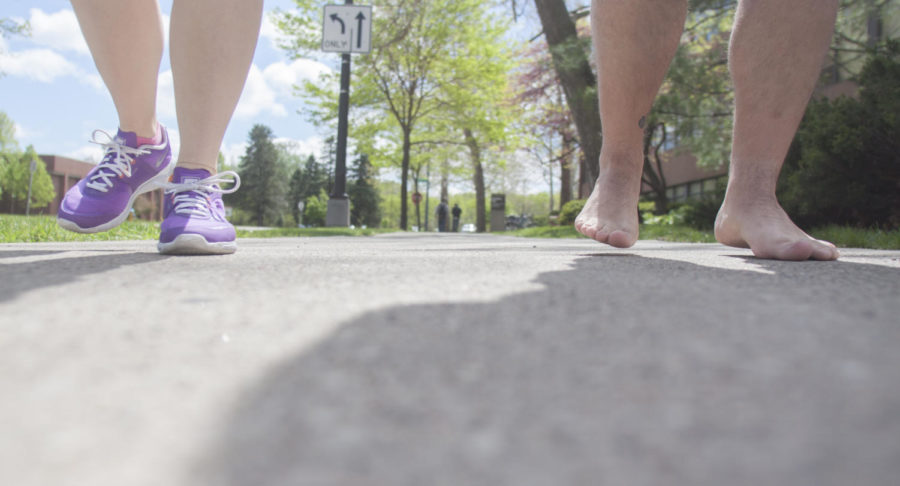Barefoot running: Newest craze or lasting phase?
Photo illustration: Kelsey Kremer/Iowa State Daily
Barefoot running forces runners to step on the ball of the foot rather than the heel, which is called forefoot running. It simplifies each step into one impact, strengthens rarely used intrinsic foot muscles and forces the runner to take smaller strides.
April 16, 2012
The recent craze in barefoot running has taken the running culture by storm, but before deciding to lose the shoes, runners should consider what it means for their bodies.
“Barefoot running is not just about being barefoot or wearing minimalist shoes, but it is a complete change in the way the body moves,” said Tim Derrick, consultant for New Balance running shoes and professor of kinesiology at Iowa State.
Barefoot running forces runners to step on the ball of the foot rather than the heel, which is called forefoot running. It simplifies each step into one impact, strengthens rarely used intrinsic foot muscles and forces the runner to take smaller strides.
Since modern running shoes were developed in the 1970s, running injuries are said to have stayed consistent regardless of modern technology, Derrick said.
“Some people believe running shoes are the root of running injuries, because shoes cradle the foot unnaturally,” Derrick said.
The idea that running shoes are unhelpful in preventing injuries inspired the development of the barefoot running craze.
“Runners are willing to try anything in order to find a solution to their running injuries,” Derrick said.
But because barefoot running is such a recent phenomenon, little actual research is available to support health claims.
“Barefoot running is hard to justify because there is a lot of room for error,” said West Des Moines podiatrist Kirk Neustrom. “I have seen many stress fractures and puncture injuries from people who try barefoot running.”
Neustrom said that he would never suggest barefoot running to his patients, unless they were experienced runners who had been injured from heel-first running styles.
Because barefoot running is a forefoot running style, smaller and more fragile bones in the ball of the foot receive the most impact. Typical heel-first running puts the pressure on the calcaneus, a larger bone, which can better absorb the impact.
If a runner decides they can benefit from barefoot running, they must take the transition in running style very slowly, Derrick said.
“When I purchased Vibram FiveFingers, I was given a lot of advice from the company on how to ‘ease’ my way into using the shoes,” said Elena Carvell, junior in pre-biological and pre-medical illustration and a 21-year-old barefoot runner.
Emily Armstrong, shoes specialist at Jax Outdoor Gear, said it is her job to go beyond making the sale, but to also make sure that barefoot running is right for the customer.
“The transition must be taken very slowly, on the right surface and should first be used as a cross-training method rather than an end-all running style,” Armstrong said.
For Joe Sevcik, junior in kinesiology and health and 20-year-old marathon runner, running is not about trying something new but what he knows works best for his body.
“I know that I am happy and healthy in my standard running shoes,” Sevcik said. “All experienced runners I know use running shoes that fit them correctly before they try something as extreme as barefoot running.”
Because Vibram FiveFingers and minimalist shoes are a fad in the running culture, Neustrom said barefoot running has become a novelty and health effects are no longer the primary concern for customers.
“I would definitely be wary to jump on the bandwagon,” Neustrom said. “I think barefoot running will end up like bell bottoms … just a craze.”

















